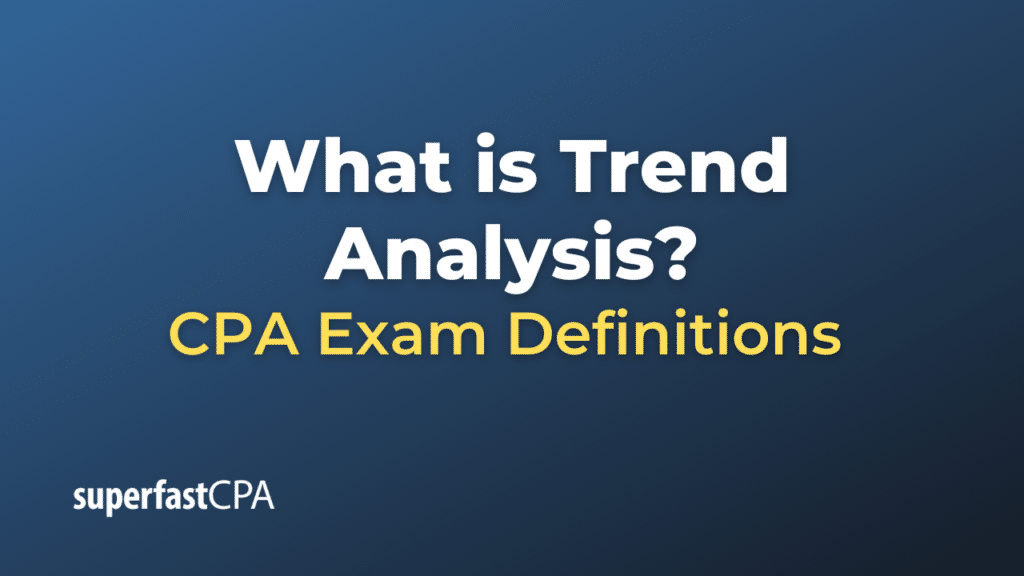Trend Analysis
Trend analysis is a statistical technique used to examine and identify a pattern or trend in data over time. In financial analysis, trend analysis often refers to the analysis of financial statements to identify changes and patterns in financial performance over consecutive periods. However, trend analysis can be applied in various fields, including but not limited to stock market analysis, economic research, environmental studies, and even in healthcare.
In its simplest form, trend analysis is about plotting data points over time and then forming a line of best fit (often using linear regression) to identify the general direction or pattern of the data.
Key Components of Trend Analysis:
- Time Period: Trend analysis requires consistent data over a specific period. The length of this period depends on the subject of analysis. For stocks, it could be days or months, while for financial statement analysis, it’s typically years.
- Data Points: These are specific values or observations collected at regular intervals over the time period in question.
- Trend Line: This is a line that best represents the data. It can be upward (indicating growth), flat (indicating stability), or downward (indicating decline).
Benefits of Trend Analysis:
- Predictive Insights: By examining past trends, analysts can make educated predictions about future movements or outcomes.
- Identification of Anomalies: Any significant deviation from an established trend can be easily spotted and investigated.
- Decision Making: Trends provide a clearer picture of the bigger scenario, aiding in both strategic and operational decisions.
- Performance Evaluation: For businesses, comparing current performance against past trends can offer insights into how well the company is doing.
Examples of Trend Analysis:
- Stock Market: An investor might look at the 50-day moving average of a stock’s price to determine its short-term trend. If the current price is above this average, the stock may be in an upward trend.
- Sales Analysis: A retailer might analyze monthly sales data over several years to identify seasonal trends, which can then inform inventory decisions.
- Economic Research: Economists might use trend analysis to track unemployment rates over a decade to understand economic health and cycles.
- Environmental Studies: Scientists might use trend analysis to study global temperature changes over the years to research climate change.
When using trend analysis, it’s crucial to remember that while it’s beneficial for forecasting, the predictions are based on the assumption that past trends will continue into the future. External factors, sudden events, or changes in conditions can disrupt established trends.
Example of Trend Analysis
Let’s delve into a detailed, fictional example to illustrate trend analysis in a business context.
Scenario: Sarah is the CEO of “TechGlow,” a company that produces smart light bulbs. As part of her yearly review, she wants to assess the sales performance of her products over the last five years.
Data Collection: Sarah gathers the annual sales data (in units sold) for the past five years:
- 2019: 50,000 units
- 2020: 52,500 units
- 2021: 56,000 units
- 2022: 59,500 units
- 2023: 63,000 units
Trend Analysis:
- Plotting Data Points: Sarah plots the sales data on a graph, with years on the x-axis and units sold on the y-axis.
- Drawing the Trend Line: Using a simple linear regression, Sarah draws a line of best fit. The line shows an upward trajectory, indicating a consistent growth trend in sales over the last five years.
- Calculating Growth Rate: Sarah calculates the average year-over-year growth rate. The growth rate from 2019 to 2020 is 5%, and it remains consistent over the subsequent years.
Interpretation:
- Consistent Growth: The upward trend line and consistent growth rate of 5% signify that TechGlow has been experiencing steady sales growth over the past five years.
- Forecasting: Based on the current trend, Sarah can predict that in 2024, the sales might be around 66,150 units (assuming a 5% growth from 2023).
- Strategic Decision: Seeing the positive trend, Sarah decides it’s an appropriate time to introduce a new line of smart home products, expecting that the company’s positive trajectory and brand strength will support the new product launch.
- Identifying Anomalies: Sarah notices that while the overall trend is upward, there was a minor dip in sales growth during a particular quarter in 2021. Upon further investigation, she discovers that there were supply chain disruptions during that period. With this insight, she emphasizes strengthening the supply chain to avoid future disruptions.
This example showcases how trend analysis can provide invaluable insights into business performance, support forecasting, and inform strategic decisions.













